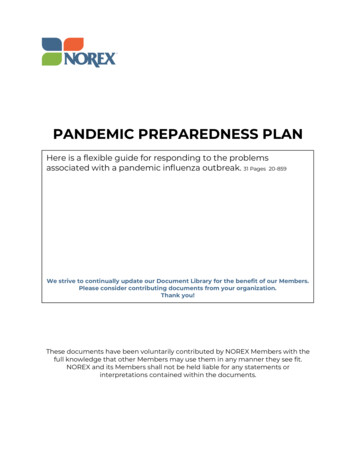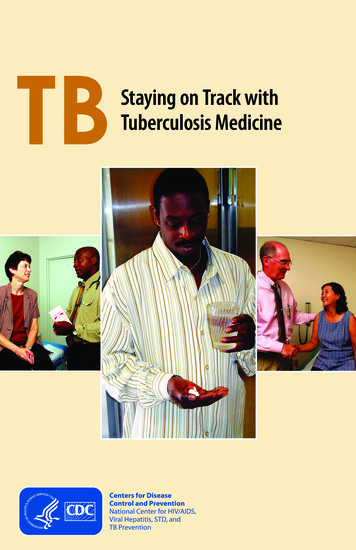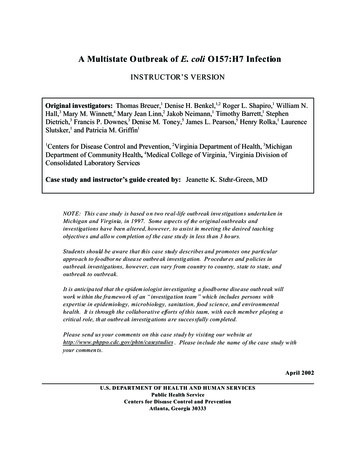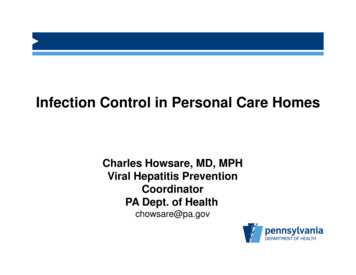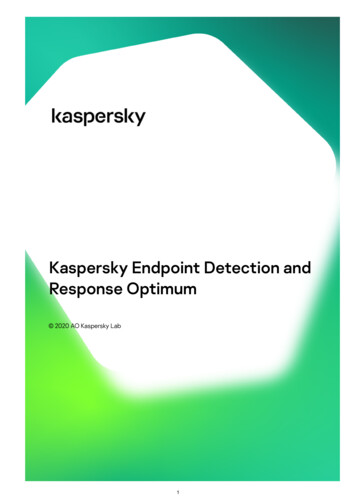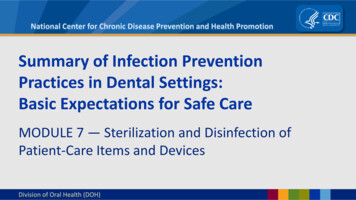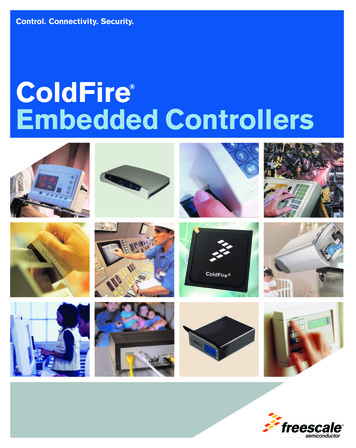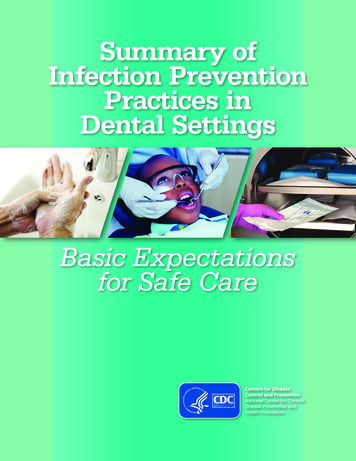
Transcription
Summary ofInfection PreventionPractices inDental SettingsBasic Expectationsfor Safe Care
Note to ReadersThis document is a summary guide of basicinfection prevention recommendations forall dental health care settings. These includetraditional settings such as private dentalpractices, dental clinics, dental schoolsand educational programs (includingdental assisting, dental hygiene, andlaboratory) and nontraditional settingsthat often use portable dental equipmentsuch as clinics held in schools for sealantand fluoride placement and in othersites for humanitarian dental missions.While the information included in thisdocument reflects existing evidence-basedguidelines produced by the Centers forDisease Control and Prevention (CDC), itis not intended as a replacement for moreextensive guidelines. This summary guide isbased primarily upon elements of StandardPrecautions and represents a summary ofbasic infection prevention expectations forsafe care in dental settings as recommendedin the Guidelines for Infection Control inDental Health-Care Settings — 2003. Readersare urged to use the Infection PreventionChecklist for Dental Settings (AppendixA), a companion to the summary; and toconsult the full guidelines for additionalbackground, rationale, and scientificevidence behind each recommendation.Suggested CitationCenters for Disease Control and Prevention. Summary of Infection Prevention Practices in Dental Settings:Basic Expectations for Safe Care. Atlanta, GA: Centers for Disease Control and Prevention, US Dept of Healthand Human Services; October 2016.Adapted from: Guide to Infection Prevention for Outpatient Settings: Minimum Expectations for Safe patient-care-guidelines.htmlii
ContentsSuggested Citation.iiIntroduction. 2Objectives. 3Fundamental Elements Needed to Prevent Transmission of InfectiousAgents in Dental Settings. 4Administrative Measures. 4Infection Prevention Education and Training . 4Dental Health Care Personnel Safety. 5Program Evaluation. 6Standard Precautions. 6Hand Hygiene. 7Personal Protective Equipment. 7Respiratory Hygiene / Cough Etiquette. 8Sharps Safety. 9Safe Injection Practices.10Sterilization and Disinfection of Patient-Care Items and Devices. 12Environmental Infection Prevention and Control.14Dental Unit Water Quality. 15Risk Assessment .16Conclusions.16Source Documents. 17Appendix A: Infection Prevention Checklist for Dental Settings: BasicExpectations for Safe Care.18Section I: Policies and Practices. 19Section II: Direct Observation of Personnel and Patient-Care Practices.27Appendix B: Relevant Recommendations Published by CDC Since 2003.36Appendix C: Selected References and Additional Resourcesby Topic Area.381
IntroductionTransmission of infectious agents among patientsand dental health care personnel (DHCP) in dentalsettings is rare. However, from 2003 to 2015,transmissions in dental settings, including patientto-patient transmissions, have been documented.1 – 4In most cases, investigators failed to link a specificlapse of infection prevention and control witha particular transmission. However, reportedbreakdowns in basic infection prevention proceduresincluded unsafe injection practices, failure to heatsterilize dental handpieces between patients, andfailure to monitor (e.g., conduct spore testing)autoclaves.2,3 These reports highlight the need forcomprehensive training to improve understandingof underlying principles, recommended practices,their implementation, and the conditions thathave to be met for disease transmission.All dental settings, regardless of the level ofcare provided, must make infection preventiona priority and should be equipped to observeStandard Precautions and other infection preventionrecommendations contained in CDC’s Guidelines forInfection Control in Dental Health-Care Settings — 2003.5The Summary of Infection Prevention Practices in DentalSettings: Basic Expectations for Safe Care summarizescurrent infection prevention recommendations andincludes a checklist (Appendix A) that can be used toevaluate compliance.The information presented here is based primarilyupon the recommendations from the 2003 guidelineand represents infection prevention expectations forsafe care in dental settings. It is intended for use byanyone needing information about basic infectionprevention measures in dental health care settings,but is not a replacement for the more extensiveguidelines. Readers are urged to consult the fullguidelines for additional background, rationale, andscientific evidence behind each recommendation.Additional topics and information relevant to dentalinfection prevention and control published by CDCsince 2003 in this document can be found inAppendix B including Infection prevention programadministrative measures. Infection prevention education and training. Respiratory hygiene and cough etiquette. Updated safe injection practices. Administrative measures for instrument processing.For the purposes of this document, DHCP refersto all paid and unpaid personnel in the dental healthcare setting who might be occupationally exposed toinfectious materials, including body substances andcontaminated supplies, equipment, environmentalsurfaces, water, or air. This includes Dentists. Dental hygienists. Dental assistants. Dental laboratory technicians(in-office and commercial). Students and trainees. Contractual personnel. Other persons not directly involved in patientcare but potentially exposed to infectious agents(e.g., administrative, clerical, housekeeping,maintenance, or volunteer personnel).52
ObjectivesFor additional references, backgroundinformation, rationale, and evidence,readers should consult the references andresources listed in Appendix C. Detailedrecommendations for dental health caresettings can be found in the compendiumdocument, Recommendations from theGuidelines for Infection Control in DentalHealth-Care Settings — 2003.By highlighting existing CDC recommendations, thissummary guide1. Provides basic infection prevention principles andrecommendations for dental health care settings.2. Reaffirms Standard Precautions as the foundationfor preventing transmission of infectious agentsduring patient care in all dental health caresettings.3. Provides links to full guidelines and sourcedocuments that readers can reference for moredetailed background and recommendations.References1. Redd JT, Baumbach J, Kohn W, et al. Patient-to-patient transmission of hepatitis B virus associated with oralsurgery. J Infect Dis. 2007;195(9):1311 – 1314.2. Radcliffe RA, Bixler D, Moorman A, et al. Hepatitis B virus transmissions associated with a portable dental clinic,West Virginia, 2009. J Am Dent Assoc. 2013;144(10):1110 – 1118.3. Oklahoma State Department of Health. Dental Healthcare-Associated Transmission of Hepatitis C: Final Reportof Public Health Investigation and Response, 2013. Available at: hcare Final%20Report 2 17 15.pdf.4. Klevens RM, Moorman AC. Hepatitis C virus: an overview for dental health care providers. J Am Dent Assoc.2013;144(12):1340 – 1347.5. Centers for Disease Control and Prevention. Guidelines for infection control in dental health-caresettings — 2003. MMWR Recomm Rep 2003;52(RR-17):1 – 61. Available at: www.cdc.gov/mmwr/PDF/rr/rr5217.pdf.3
Fundamental Elements Needed to PreventTransmission of Infectious Agents in Dental SettingsAdministrative MeasuresInfection prevention must be made a priority in anydental health care setting. At least one individualwith training in infection prevention — the infectionprevention coordinator — should be responsible fordeveloping written infection prevention policies andprocedures based on evidence-based guidelines,regulations, or standards. Policies and proceduresshould be tailored to the dental setting and reassessedon a regular basis (e.g., annually) or according to stateor federal requirements. Development should take intoconsideration the types of services provided by DHCPand the patient population served, extending beyondthe Occupational Safety and Health Administration(OSHA) bloodborne pathogens standard to addresspatient safety. The infection prevention coordinatorshould ensure that equipment and supplies (e.g.,hand hygiene products, safer devices to reducepercutaneous injuries, and personal protectiveequipment) are available and should maintaincommunication with all staff members to addressspecific issues or concerns related to infectionprevention. In addition, all dental settings shouldhave policies and protocols for early detection andmanagement of potentially infectious persons at initialpoints of patient encounter.Key ADMINISTRATIVE RECOMMENDATIONSfor Dental Settings1. Develop and maintain infection preventionand occupational health programs.4. Develop and maintain written infectionprevention policies and proceduresappropriate for the services provided bythe facility and based on evidence-basedguidelines, regulations, or standards.2. Provide supplies necessary foradherence to Standard Precautions(e.g., hand hygiene products, saferdevices to reduce percutaneous injuries,personal protective equipment).5. Facility has system for early detection andmanagement of potentially infectiouspersons at initial points of patient encounter.3. Assign at least one individual trainedin infection prevention responsibilityfor coordinating the program.Infection Prevention Education and TrainingOngoing education and training of DHCP are criticalfor ensuring that infection prevention policies andprocedures are understood and followed. Educationon the basic principles and practices for preventingthe spread of infections should be provided to allDHCP. Training should include both DHCP safety(e.g., OSHA bloodborne pathogens training) andpatient safety (e.g., emphasizing job- or task-specificneeds). Education and training should be providedduring orientation to the setting, when new tasksor procedures are introduced and at a minimum,annually. Training records should be maintainedaccording to state and federal requirements.4
Key Recommendations for EDUCATION AND TRAININGin Dental Settings1. Provide job- or task-specific infectionprevention education and trainingto all DHCP.2. Provide training on principles of bothDHCP safety and patient safety.3. Provide training during orientation andat regular intervals (e.g., annually).a. This includes those employed by outsideagencies and available by contract oron a volunteer basis to the facility.4. Maintain training records accordingto state and federal requirements.Dental Health Care Personnel SafetyInfection prevention programs should also addressoccupational health needs, including vaccinationof DHCP, management of exposures or infections inpersonnel requiring post-exposure prophylaxis or workrestrictions, and compliance with OSHA bloodbornepathogens standard. Referral arrangements for medicalservices can be made with qualified health careprofessionals in an occupational health program of ahospital, with educational institutions, or with healthcare facilities that offer personnel health services.Recommendations for prevention of infections inDHCP can be found in the following documents —Guidelines for Infection Control in Dental HealthCare Settings — 2003 (available at: www.cdc.gov/mmwr/PDF/rr/rr5217.pdf ), Immunization ofHealth-Care Personnel: Recommendations of theAdvisory Committee on Immunization Practices (ACIP)(available at: http://www.cdc.gov/mmwr/pdf/rr/rr6007.pdf ), and OSHA Bloodborne Pathogens andNeedlestick Prevention (available at: .html).Key Recommendations forDENTAL HEALTH CARE PERSONNEL SAFETY1. Current CDC recommendations forimmunizations, evaluation, and followup are available. There is a writtenpolicy regarding immunizing DHCP,including a list of all required andrecommended immunizations for DHCP(e.g., hepatitis B, MMR (measles, mumps,and rubella) varicella (chickenpox),Tdap (tetanus, diphtheria, pertussis).3. Referral arrangements are in place toqualified health care professionals (e.g.,occupational health program of a hospital,educational institutions, health care facilitiesthat offer personnel health services) toensure prompt and appropriate provisionof preventive services, occupationallyrelated medical services, and postexposuremanagement with medical follow-up.2. All DHCP are screened for tuberculosis(TB) upon hire regardless of the riskclassification of the setting.4. Facility has well-defined policiesconcerning contact of personnelwith patients when personnel havepotentially transmissible conditions.5
Program EvaluationA successful infection prevention program depends on Developing standard operating procedures. Evaluating practices and providingfeedback to DHCP. Routinely documenting adverse outcomes(e.g., occupational exposures to blood)and work-related illnesses in DHCP. Monitoring health care associatedinfections in patients.Strategies and tools to evaluate the infectionprevention program can include periodicobservational assessments, checklists to documentprocedures, and routine review of occupationalexposures to bloodborne pathogens. The InfectionPrevention Checklist for Dental Settings found inAppendix A is one tool DHCP can use to evaluatetheir infection prevention program. Evaluation offersan opportunity to improve the effectiveness ofboth the infection-prevention program and dentalpractice protocols. If deficiencies or problems in theimplementation of infection prevention proceduresare identified — further evaluation and feedback,corrective action, and training (if applicable) is neededto eliminate the problems.Key Recommendation forPROGRAM EVALUATION in Dental Settings1. Establish routine evaluation of the infection prevention program, including evaluation of DHCPadherence to infection prevention practices.Standard PrecautionsStandard Precautions are the minimum infectionprevention practices that apply to all patient care,regardless of suspected or confirmed infection statusof the patient, in any setting where health care isdelivered. These practices are designed to both protectDHCP and prevent DHCP from spreading infectionsamong patients. Standard Precautions include —1. Hand hygiene.2. Use of personal protective equipment (e.g., gloves,masks, eyewear).3. Respiratory hygiene / cough etiquette.4. Sharps safety (engineering and work practicecontrols).5. Safe injection practices (i.e., aseptic technique forparenteral medications).6. Sterile instruments and devices.7. Clean and disinfected environmental surfaces.critical elements of Standard Precautions, because theyhelp DHCP make appropriate decisions and complywith recommended practices.When Standard Precautions alone cannotprevent transmission, they are supplemented withTransmission-Based Precautions. This second tierof infection prevention is used when patients havediseases that can spread through contact, dropletor airborne routes (e.g., skin contact, sneezing,coughing) and are always used in addition to StandardPrecautions. Dental settings are not typically designedto carry out all of the Transmission-Based Precautions(e.g., Airborne Precautions for patients with suspectedtuberculosis, measles, or chickenpox) that arerecommended for hospital and other ambulatorycare settings. Patients, however, do not usually seekroutine dental outpatient care when acutely ill withdiseases requiring Transmission-Based Precautions.Nonetheless, DHCP should develop and carry outsystems for early detection and management ofEach element of Standard Precautions is describedin the following sections. Education and training are6
potentially infectious patients at initial points ofentry to the dental setting. To the extent possible,this includes rescheduling non-urgent dental careuntil the patient is no longer infectious or referral to adental setting with appropriate infection preventionprecautions when urgent dental treatment is needed.Hand HygieneHand hygiene is the most important measure toprevent the spread of infections among patientsand DHCP. Education and training programs shouldthoroughly address indications and techniques forhand hygiene practices before performing routineand oral surgical procedures.For routine dental examinations and nonsurgicalprocedures, use water and plain soap (hand washing)or antimicrobial soap (hand antisepsis) specific forhealth care settings or use an alcohol-based hand rub.Although alcohol-based hand rubs are effective forhand hygiene in health care settings, soap and watershould be used when hands are visibly soiled (e.g., dirt,blood, body fluids). For surgical procedures,1 perform asurgical hand scrub before putting on sterile surgeon’sgloves. For all types of hand hygiene products, followthe product manufacturer’s label for instructions.Complete guidance on how and when hand hygieneshould be performed, including recommendationsregarding surgical hand antisepsis and artificial nailscan be found in the Guideline for Hand Hygiene inHealth-Care Settings (available at: http://www.cdc.gov/mmwr/PDF/rr/rr5116.pdf ).Key Recommendations for HAND HYGIENEin Dental Settings1. Perform hand hygiene —c. Before and after treating each patient.a. When hands are visibly soiled.d. Before putting on gloves and againimmediately after removing gloves.b. After barehanded touching ofinstruments, equipment, materials, andother objects likely to be contaminatedby blood, saliva, or respiratory secretions.2. Use soap and water when hands are visiblysoiled (e.g., blood, body fluids); otherwise,an alcohol-based hand rub may be used.Personal Protective EquipmentPersonal protective equipment (PPE) refers to wearableequipment that is designed to protect DHCP fromexposure to or contact with infectious agents. PPE thatis appropriate for various types of patient interactionsand effectively covers personal clothing and skin likelyto be soiled with blood, saliva, or other potentiallyinfectious materials (OPIM) should be available. Theseinclude gloves, face masks, protective eye wear, faceshields, and protective clothing (e.g., reusable or1disposable gown, jacket, laboratory coat). Examplesof appropriate use of PPE for adherence to StandardPrecautions include — Use of gloves in situations involving possiblecontact with blood or body fluids, mucousmembranes, non-intact skin (e.g., exposed skin thatis chapped, abraded, or with dermatitis) or OPIM. Use of protective clothing to protect skin andclothing during procedures or activities whereDefinition from 2003 CDC Dental Guidelines — Oral surgical procedures involve the incision, excision, or reflection of tissue that exposes the normally sterileareas of the oral cavity. Examples include biopsy, periodontal surgery, apical surgery, implant surgery, and surgical extractions of teeth (e.g., removal oferupted or nonerupted tooth requiring elevation of mucoperiosteal flap, removal of bone or section of tooth, and suturing if needed).7
contact with blood or body fluids is anticipated. Use of mouth, nose, and eye protection duringprocedures that are likely to generate splashesor sprays of blood or other body fluids.DHCP should be trained to select and put onappropriate PPE and remove PPE so that the chancefor skin or clothing contamination is reduced. Handhygiene is always the final step after removing anddisposing of PPE. Training should also stress preventingfurther spread of contamination while wearing PPE by:Keeping hands away from face.Limiting surfaces touched.Removing PPE when leaving work areas.Performing hand hygiene.The application of Standard Precautions andguidance on appropriate selection and an exampleof putting on and removal of personal protectiveequipment is described in detail in the 2007 Guidelinefor Isolation Precautions (available at: 007.pdf ).Key Recommendations for PERSONAL PROTECTIVEEQUIPMENT (PPE) in Dental Settings1. Provide sufficient and appropriate PPEand ensure it is accessible to DHCP.c. Perform hand hygiene immediatelyafter removing gloves.2. Educate all DHCP on properselection and use of PPE.4. Wear protective clothing that covers skinand personal clothing during proceduresor activities where contact with blood,saliva, or OPIM is anticipated.3. Wear gloves whenever there is potentialfor contact with blood, body fluids,mucous membranes, non-intact skinor contaminated equipment.5. Wear mouth, nose, and eye protectionduring procedures that are likelyto generate splashes or spatteringof blood or other body fluids.a. Do not wear the same pair of glovesfor the care of more than one patient.6. Remove PPE before leaving the work area.b. Do not wash gloves. Glovescannot be reused.Respiratory Hygiene / Cough EtiquetteRespiratory hygiene / cough etiquette infectionprevention measures are designed to limit thetransmission of respiratory pathogens spread bydroplet or airborne routes. The strategies targetprimarily patients and individuals accompanyingpatients to the dental setting who might haveundiagnosed transmissible respiratory infections, butalso apply to anyone (including DHCP) with signs ofillness including cough, congestion, runny nose, orincreased production of respiratory secretions.DHCP should be educated on preventing the spreadof respiratory pathogens when in contact withsymptomatic persons. Respiratory hygiene / coughetiquette measures were added to StandardPrecautions in 2007. Additional information related torespiratory hygiene / cough etiquette can be found inthe 2007 Guideline for Isolation Precautions (availableat: 007.pdf ). Recommendations for preventingthe spread of influenza are available at: rol/.8
Key Recommendations for RESPIRATORY HYGIENE / COUGHETIQUETTE in Dental Settings1. Implement measures to containrespiratory secretions in patients andaccompanying individuals who have signsand symptoms of a respiratory infection,beginning at point of entry to the facilityand continuing throughout the visit.c. Provide resources for performing handhygiene in or near waiting areas.d. Offer masks to coughing patients andother symptomatic persons whenthey enter the dental setting.e. Provide space and encourage personswith symptoms of respiratory infectionsto sit as far away from others aspossible. If available, facilities maywish to place these patients in aseparate area while waiting for care.a. Post signs at entrances withinstructions to patients with symptomsof respiratory infection to —i. Cover their mouths / noseswhen coughing or sneezing.ii. Use and dispose of tissues.2. Educate DHCP on the importance ofinfection prevention measures to containrespiratory secretions to prevent the spreadof respiratory pathogens when examiningand caring for patients with signs andsymptoms of a respiratory infection.iii. Perform hand hygiene afterhands have been in contactwith respiratory secretions.b. Provide tissues and no-touchreceptacles for disposal of tissues.Sharps SafetyMost percutaneous injuries (e.g., needlestick, cut witha sharp object) among DHCP involve burs, needles,and other sharp instruments. Implementation of theOSHA Bloodborne Pathogens Standard has helped toprotect DHCP from blood exposure and sharps injuries.However, sharps injuries continue to occur and posethe risk of bloodborne pathogen transmission toDHCP and patients. Most exposures in dentistry arepreventable; therefore, each dental practice shouldhave policies and procedures available addressingsharps safety. DHCP should be aware of the risk ofinjury whenever sharps are exposed. When using orworking around sharp devices, DHCP should takeprecautions while using sharps, during cleanup, andduring disposal.Engineering and work-practice controls are theprimary methods to reduce exposures to bloodand OPIM from sharp instruments and needles.Whenever possible, engineering controls should beused as the primary method to reduce exposuresto bloodborne pathogens. Engineering controlsremove or isolate a hazard in the workplace and arefrequently technology-based (e.g., self-sheathinganesthetic needles, safety scalpels, and needleless IVports). Employers should involve those DHCP whoare directly responsible for patient care (e.g., dentists,hygienists, dental assistants) in identifying, evaluatingand selecting devices with engineered safety featuresat least annually and as they become available. Otherexamples of engineering controls include sharpscontainers and needle recapping devices.When engineering controls are not available orappropriate, work-practice controls should be used.Work-practice controls are behavior-based and areintended to reduce the risk of blood exposure bychanging the way DHCP perform tasks, such as usinga one-handed scoop technique for recapping needlesbetween uses and before disposal. Other work-9
practice controls include not bending or breakingneedles before disposal, not passing a syringe withan unsheathed needle by hand, removing bursbefore disassembling the handpiece from the dentalunit, and using instruments in place of fingers fortissue retraction or palpation during suturing andadministration of anesthesia.All used disposable syringes and needles, scalpelblades, and other sharp items should be placed inappropriate puncture-resistant containers locatedclose to the area where they are used. Sharpscontainers should be disposed of according to stateand local regulated medical waste rules.For more information about sharps safety, see theGuidelines for Infection Control in Dental Health-CareSettings — 2003 (available at: www.cdc.gov/mmwr/PDF/rr/rr5217.pdf ), the CDC Workbook for Designing,Implementing, and Evaluating a Sharps Injury PreventionProgram (available at: www.cdc.gov/sharpssafety/),and the CDC Sample Screening and Device EvaluationForms for Dentistry (available at: .Key Recommendations for SHARPS SAFETYin Dental Settings1. Consider sharp items (e.g., needles,scalers, burs, lab knives, and wires) thatare contaminated with patient bloodand saliva as potentially infective andestablish engineering controls andwork practices to prevent injuries.3. Use either a one-handed scoop techniqueor a mechanical device designed forholding the needle cap when recappingneedles (e.g., between multipleinjections and before removing from anon-disposable aspirating syringe).2. Do not recap used needles by usingboth hands or any other techniquethat involves directing the point of aneedle toward any part of the body.4. Place used disposable syringes andneedles, scalpel blades, and other sharpitems in appropriate puncture-resistantcontainers located as close as possibleto the area where the items are used.S
This document is a summary guide of basic infection prevention recommendations for all dental health care settings. These include traditional settings such as private dental practices, dental clinics, dental schools and educational programs (including dental assisting, dental

